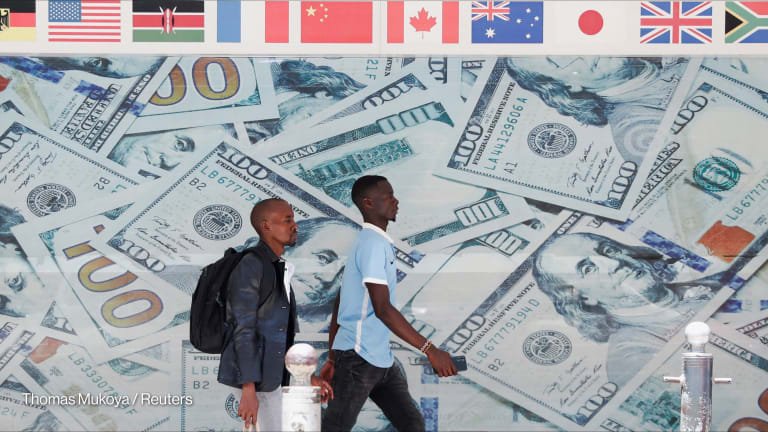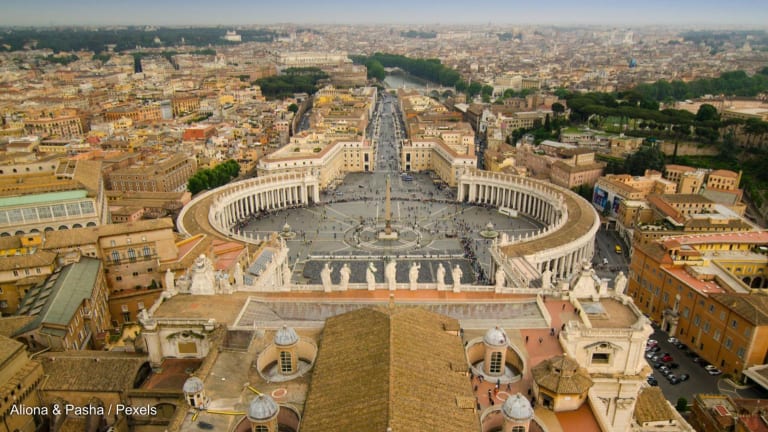Is Zambia's debt default a sign of things to come?
Experts say Zambia's default will further stifle the country's development, offering a cautionary tale for other debt distressed economies.
GABORONE, Botswana — Last week, Zambia became the first African country to default on its sovereign debt amid the COVID-19 pandemic. This came after Eurobond holders rejected Zambia’s request to defer interest payments for six months, leaving the country with less than 24 hours to make an interest payment of $42.5 million — a demand it couldn’t meet. Trevor Hambayi, a Lusaka-based financial analyst, explained that defaulting means the country’s credit rating will move into junk status and it won’t be able to access the loans it needs to support development. “We have been running the country with a budget on borrowed funds,” he said. The government needed to borrow an additional $1.4 billion to fund the 2021 budget, which it will no longer be able to get from the international market, he said. Zambia has an estimated $12 billion in external debt. As with many of its African neighbors, the resources put into servicing those debts means less money for education, health care, and other essential public services. The situation has only been worsened by the pandemic, during which demands on government coffers have skyrocketed just as the economy has taken a massive hit. Defaulting will worsen Zambia’s financial woes, experts say, further stunting its development and making it harder for the government to meet the needs brought on by the pandemic. But while some worry it could be bad news for other distressed economies, many of whom were looking to Zambia as an example of how creditors might treat them in the current circumstances, local economists say this is not necessarily the case, pointing to specific conditions that hindered Zambia from reaching an agreement with the Eurobond holders. Zambia’s rising debt Zambia’s estimated external debt increased from 32% to 88% of gross domestic product between 2014 and 2019, with borrowing mostly coming from China, according to estimates, as well as several billion from the Eurobond market. Ratings agency Moody’s has estimated this figure will rise to more than 110% of the country’s GDP this year. Some reports also suggest its real debt figures are much higher than indicated by official statistics, as these do not include loans from China for public-private partnership infrastructure deals. As in other countries, Zambia’s rising debt levels have stifled development in the country, according to Ishmael Zulu, program officer at the Consumer Unity and Trust Society in Lusaka. For example, while the proportion of the national budget going to servicing debt increased between 2017 and 2021, the allocation for education fell from 16.5% to 11.5% — way below the international benchmark for education spending of 20% of total government expenditure. Zambia’s debt repayments are so high that it has to keep borrowing in order to survive. Defaulting will make it more difficult for the government to access loans, Zulu explained, meaning it will have even fewer resources to fund development activities and public services. Hambayi added that defaulting will put the country in a position where international perceptions affect inflows and outflows, putting pressure on the currency and most likely leading to a gradual depreciation. Being shut out from international markets will also force the government to raise money from the domestic market, which could drive inflation. Finally, defaulting will impact the country’s ability to secure a bailout package from the International Monetary Fund, warned Oliver Saasa, chief executive officer of Lusaka-based consultancy Premier Consult. “To be in default is the worst nightmare that any government must never dream of getting into,” he said. Is Zambia setting a precedent? When the Zambian government began the negotiation process with international bondholders, economic analysts predicted it would be the first of many countries looking to restructure their debts due to the economic effects of COVID-19. Even before the pandemic, half of the world’s low-income countries were at high risk of debt distress, according to IMF. The pandemic increased these risks as spending needs rose while revenues fell due to lower growth and trade. In an effort to mitigate this, bilateral official creditors agreed to suspend debt service payments from low- and lower-middle income countries until June 2021, through the G-20 Debt Service Suspension Initiative. The World Bank estimates that DSSI will allow Zambia to suspend debt service payments totaling $165.4 million. The country also managed to finalize an agreement with the China Development Bank to defer interest payments that were due in October for six months, with the deferred principal rescheduled over the life of the facility. The country was seeking a similar agreement with its Eurobond holders, a group of lenders owning the nation’s dollar bonds. Failure to achieve that has left many wondering if this is an indication of how distressed economies will be treated by commercial creditors in the midst of the pandemic. “The major challenge is to ensure that whatever you borrow is actually generating, creating, and encouraging economic growth and is actually generating income that can repay [the debt].” --— Arve Ofstad, economist and former Norwegian ambassador to Zambia It is true, Hambayi said, that the government should not have expected its commercial lenders to accept the same terms as public lenders — and Zambia has taken on a lot of commercial debt. “You cannot treat the creditors the same because the conditions under which you signed the financing were not the same and you must appreciate that these funds are commercial; they cannot be treated the same as bilateral loans that are concessional,” he said. But local economists also believe there were specific conditions that led to this situation for Zambia, including the lack of a viable debt sustainability strategy. What Zambia got wrong The first step the country needs to take is to be transparent about its debt position, Hambayi said. “The country has not been transparent with its debt position and what type of loans they have contracted from the Chinese,” he said. This lack of transparency and the absence of a clear debt sustainability strategy hindered the country’s negotiations with its creditors, according to Premier Consult’s Saasa. “If you listen to the reasons that the bondholders are giving, they were not tough on Zambia. If you look at what the Zambian government provided [in terms of a strategy] it was laughable and anyone who understands how international dynamics work would have known that there is no way that a normal bondholder would have accepted what they presented,” he said. He added: “Government right now has to put in place a debt sustainability strategy — a debt approach that shows a level of commitment ... It can't be only by way of statement, it must be seen to be doing those things.” Arve Ofstad, an economist and former Norwegian ambassador to Zambia, added that one of the major conditions for renegotiating with Eurobond holders was that Zambia should enter into an agreement with IMF, which also needs the country to commit to a clear debt strategy. “There is a general agreement on what it takes but the IMF has been skeptical. They wanted to see the policies played out in practice. In my opinion, Zambia hasn’t been able to prove to others including the IMF, that they are able to implement their own promises,” he said. Zulu explained that in order for the country to secure an IMF bailout package, the government would need to update the law that guides the public procurement of debt, which is now outdated, and carry out a debt sustainability analysis which would look at where Zambia is right now, how much money it owes, its ability to pay that money and, if it is to get more loans, how soon those can be paid back. In seeking a bailout package, IMF’s concern has been that “even if we give you this package we will be adding on to the debt that you already have as a country. Meanwhile you do not have adequate strategies or analysis that speaks to how the debt is going to be managed … This has been the challenge also with the Eurobond holders,” he said. Lessons learned Looking ahead, Hambayi believes there are lessons to be learnt from the Zambian situation: First and foremost, the need for long-term planning. “Every 20 years we are coming back to a position where we are defaulting on our loans and we think that we can get relief and I think that is a lesson we need to learn in terms of planning for our future,” he said. The economists noted that not only has Zambia taken on a lot of expensive commercial debt, it has also used those loans in ways that were problematic. For example, it paid exorbitant prices for some infrastructure projects — a result of possible “kick-backs” for the contracts, according to Saasa. In addition, the return on investment for such projects is quite long term, whereas the money borrowed needs to be repaid within a shorter period. “There is nothing wrong in borrowing money if you do not have enough yourself,” Ofstad said. “But I think the major challenge is to ensure that whatever you borrow is actually generating, creating, and encouraging economic growth and is actually generating income that can repay [the debt]. So it’s not only about not borrowing beyond your means but also making sure whatever you borrow you actually invest in a wise way.” Saasa believes the country offers a cautionary tale for other debt distressed economies. “If there is anything that we have learned from Zambia it is how not to do it … You can become wiser by knowing what not to do and Zambia is replete with examples,” he said.
GABORONE, Botswana — Last week, Zambia became the first African country to default on its sovereign debt amid the COVID-19 pandemic.
This came after Eurobond holders rejected Zambia’s request to defer interest payments for six months, leaving the country with less than 24 hours to make an interest payment of $42.5 million — a demand it couldn’t meet.
Trevor Hambayi, a Lusaka-based financial analyst, explained that defaulting means the country’s credit rating will move into junk status and it won’t be able to access the loans it needs to support development.
This story is forDevex Promembers
Unlock this story now with a 15-day free trial of Devex Pro.
With a Devex Pro subscription you'll get access to deeper analysis and exclusive insights from our reporters and analysts.
Start my free trialRequest a group subscription Printing articles to share with others is a breach of our terms and conditions and copyright policy. Please use the sharing options on the left side of the article. Devex Pro members may share up to 10 articles per month using the Pro share tool ( ).
Rumbi Chakamba is a Senior Editor at Devex based in Botswana, who has worked with regional and international publications including News Deeply, The Zambezian, Outriders Network, and Global Sisters Report. She holds a bachelor's degree in international relations from the University of South Africa.








